Market Investigation Techniques Analysis
VerifiedAdded on 2020/07/22
|10
|2693
|47
AI Summary
This assignment requires students to investigate market dynamics using various techniques like PESTLE (Political, Economic, Social, Technological, Environmental, Legal) analysis and competitor analysis. Students will evaluate the market for a novel oxy-turbine power cycle with complete CO2 capture, utilizing references from books and journals on business analysis, project management, and competitive analytics.
Contribute Materials
Your contribution can guide someone’s learning journey. Share your
documents today.
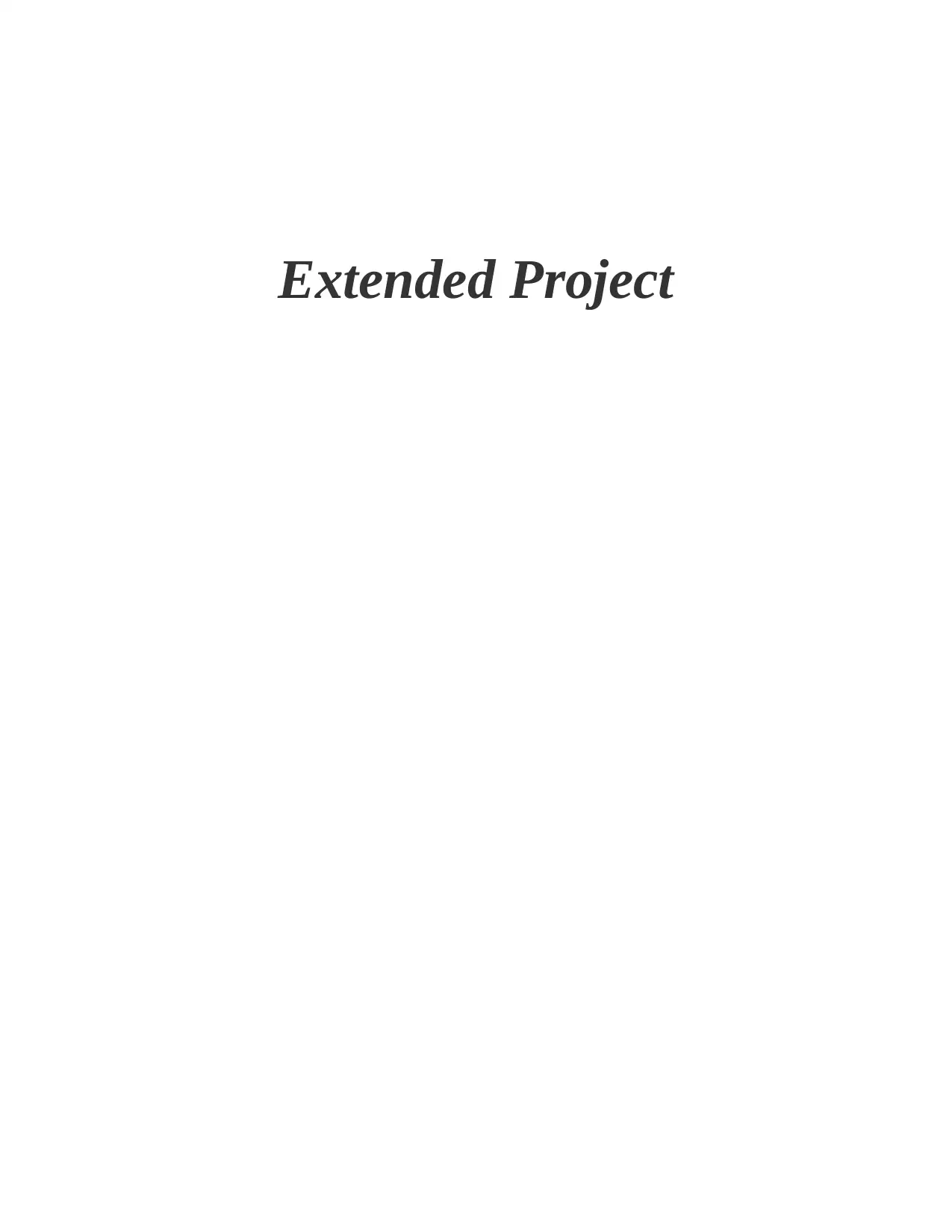
Extended Project
Secure Best Marks with AI Grader
Need help grading? Try our AI Grader for instant feedback on your assignments.
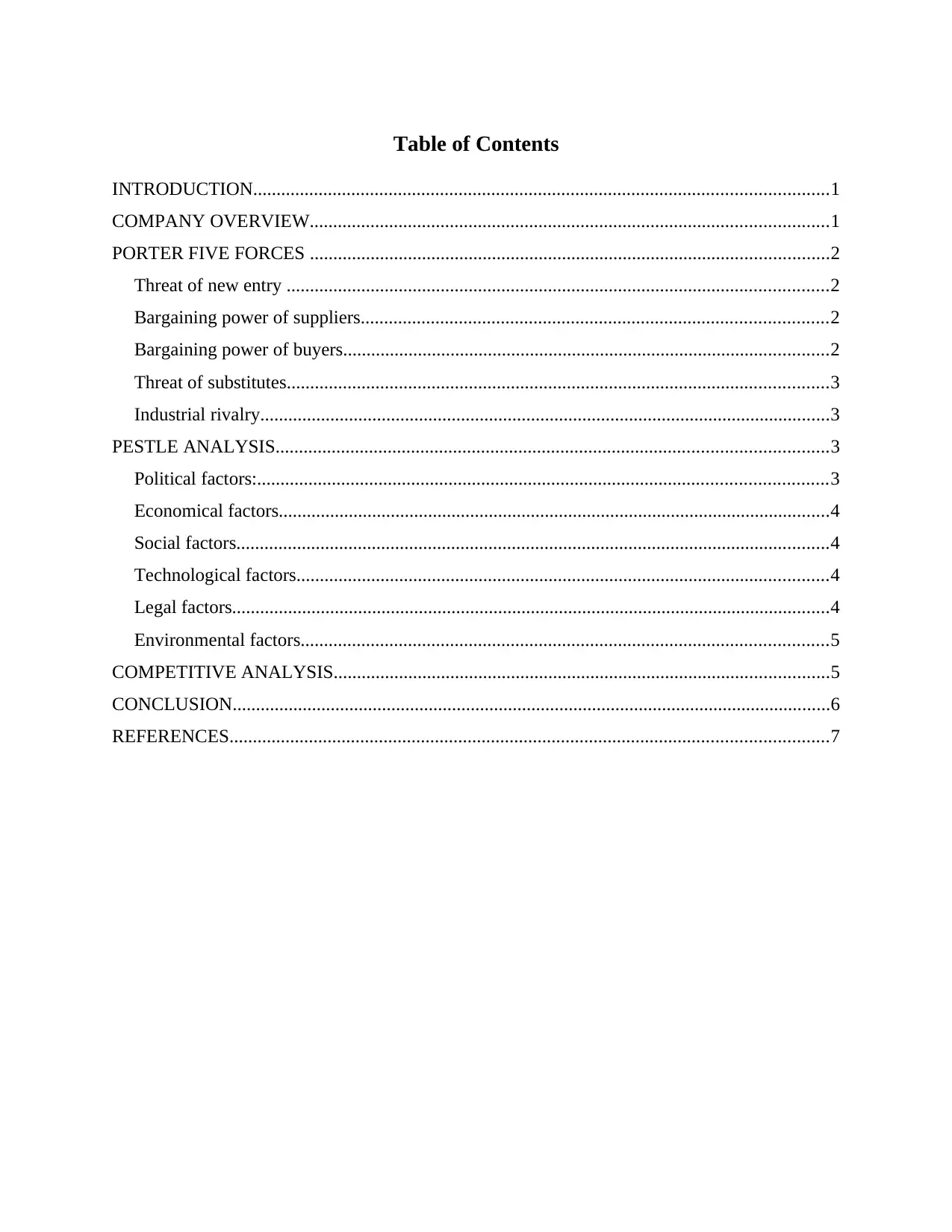
Table of Contents
INTRODUCTION...........................................................................................................................1
COMPANY OVERVIEW...............................................................................................................1
PORTER FIVE FORCES ...............................................................................................................2
Threat of new entry ....................................................................................................................2
Bargaining power of suppliers....................................................................................................2
Bargaining power of buyers........................................................................................................2
Threat of substitutes....................................................................................................................3
Industrial rivalry..........................................................................................................................3
PESTLE ANALYSIS......................................................................................................................3
Political factors:..........................................................................................................................3
Economical factors......................................................................................................................4
Social factors...............................................................................................................................4
Technological factors..................................................................................................................4
Legal factors................................................................................................................................4
Environmental factors.................................................................................................................5
COMPETITIVE ANALYSIS..........................................................................................................5
CONCLUSION................................................................................................................................6
REFERENCES................................................................................................................................7
INTRODUCTION...........................................................................................................................1
COMPANY OVERVIEW...............................................................................................................1
PORTER FIVE FORCES ...............................................................................................................2
Threat of new entry ....................................................................................................................2
Bargaining power of suppliers....................................................................................................2
Bargaining power of buyers........................................................................................................2
Threat of substitutes....................................................................................................................3
Industrial rivalry..........................................................................................................................3
PESTLE ANALYSIS......................................................................................................................3
Political factors:..........................................................................................................................3
Economical factors......................................................................................................................4
Social factors...............................................................................................................................4
Technological factors..................................................................................................................4
Legal factors................................................................................................................................4
Environmental factors.................................................................................................................5
COMPETITIVE ANALYSIS..........................................................................................................5
CONCLUSION................................................................................................................................6
REFERENCES................................................................................................................................7

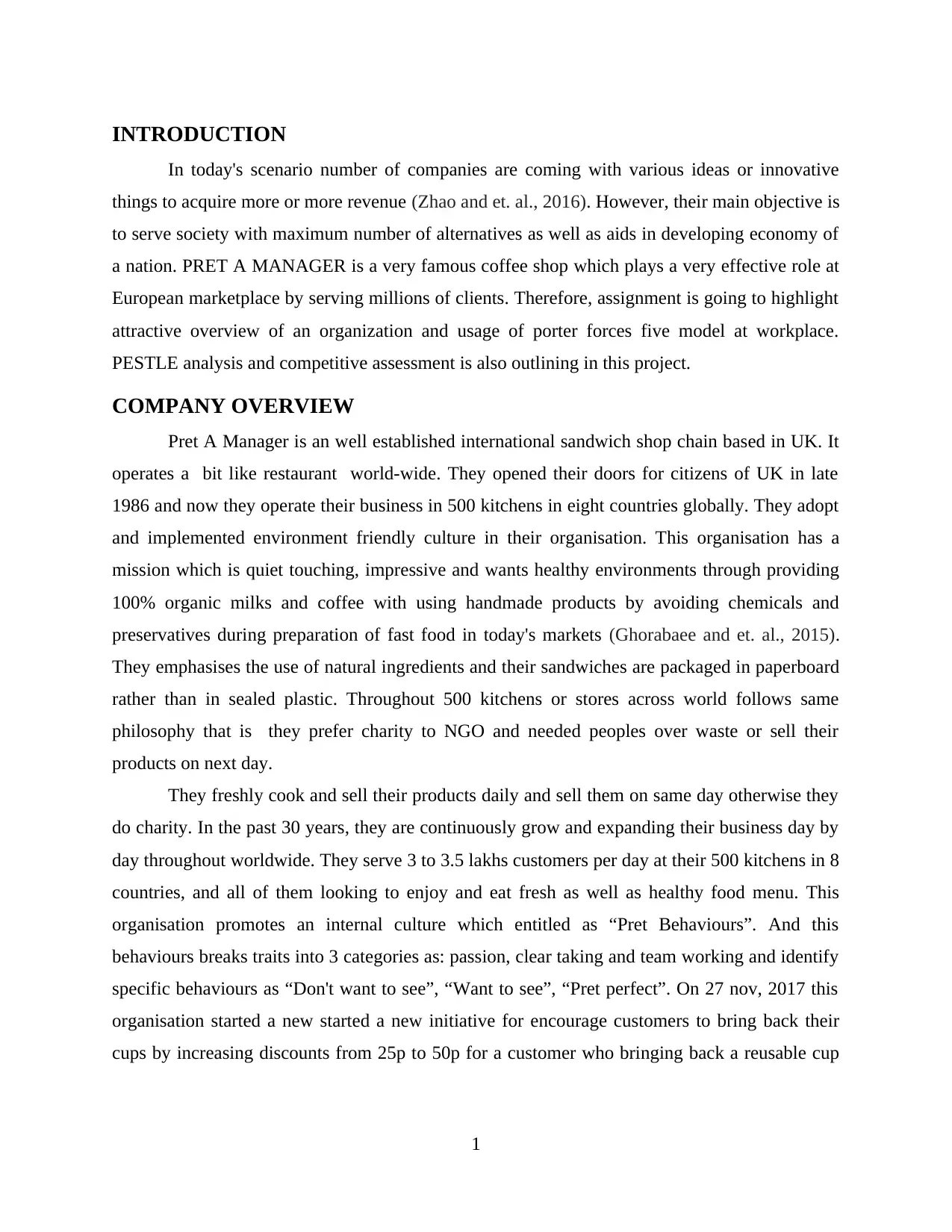
INTRODUCTION
In today's scenario number of companies are coming with various ideas or innovative
things to acquire more or more revenue (Zhao and et. al., 2016). However, their main objective is
to serve society with maximum number of alternatives as well as aids in developing economy of
a nation. PRET A MANAGER is a very famous coffee shop which plays a very effective role at
European marketplace by serving millions of clients. Therefore, assignment is going to highlight
attractive overview of an organization and usage of porter forces five model at workplace.
PESTLE analysis and competitive assessment is also outlining in this project.
COMPANY OVERVIEW
Pret A Manager is an well established international sandwich shop chain based in UK. It
operates a bit like restaurant world-wide. They opened their doors for citizens of UK in late
1986 and now they operate their business in 500 kitchens in eight countries globally. They adopt
and implemented environment friendly culture in their organisation. This organisation has a
mission which is quiet touching, impressive and wants healthy environments through providing
100% organic milks and coffee with using handmade products by avoiding chemicals and
preservatives during preparation of fast food in today's markets (Ghorabaee and et. al., 2015).
They emphasises the use of natural ingredients and their sandwiches are packaged in paperboard
rather than in sealed plastic. Throughout 500 kitchens or stores across world follows same
philosophy that is they prefer charity to NGO and needed peoples over waste or sell their
products on next day.
They freshly cook and sell their products daily and sell them on same day otherwise they
do charity. In the past 30 years, they are continuously grow and expanding their business day by
day throughout worldwide. They serve 3 to 3.5 lakhs customers per day at their 500 kitchens in 8
countries, and all of them looking to enjoy and eat fresh as well as healthy food menu. This
organisation promotes an internal culture which entitled as “Pret Behaviours”. And this
behaviours breaks traits into 3 categories as: passion, clear taking and team working and identify
specific behaviours as “Don't want to see”, “Want to see”, “Pret perfect”. On 27 nov, 2017 this
organisation started a new started a new initiative for encourage customers to bring back their
cups by increasing discounts from 25p to 50p for a customer who bringing back a reusable cup
1
In today's scenario number of companies are coming with various ideas or innovative
things to acquire more or more revenue (Zhao and et. al., 2016). However, their main objective is
to serve society with maximum number of alternatives as well as aids in developing economy of
a nation. PRET A MANAGER is a very famous coffee shop which plays a very effective role at
European marketplace by serving millions of clients. Therefore, assignment is going to highlight
attractive overview of an organization and usage of porter forces five model at workplace.
PESTLE analysis and competitive assessment is also outlining in this project.
COMPANY OVERVIEW
Pret A Manager is an well established international sandwich shop chain based in UK. It
operates a bit like restaurant world-wide. They opened their doors for citizens of UK in late
1986 and now they operate their business in 500 kitchens in eight countries globally. They adopt
and implemented environment friendly culture in their organisation. This organisation has a
mission which is quiet touching, impressive and wants healthy environments through providing
100% organic milks and coffee with using handmade products by avoiding chemicals and
preservatives during preparation of fast food in today's markets (Ghorabaee and et. al., 2015).
They emphasises the use of natural ingredients and their sandwiches are packaged in paperboard
rather than in sealed plastic. Throughout 500 kitchens or stores across world follows same
philosophy that is they prefer charity to NGO and needed peoples over waste or sell their
products on next day.
They freshly cook and sell their products daily and sell them on same day otherwise they
do charity. In the past 30 years, they are continuously grow and expanding their business day by
day throughout worldwide. They serve 3 to 3.5 lakhs customers per day at their 500 kitchens in 8
countries, and all of them looking to enjoy and eat fresh as well as healthy food menu. This
organisation promotes an internal culture which entitled as “Pret Behaviours”. And this
behaviours breaks traits into 3 categories as: passion, clear taking and team working and identify
specific behaviours as “Don't want to see”, “Want to see”, “Pret perfect”. On 27 nov, 2017 this
organisation started a new started a new initiative for encourage customers to bring back their
cups by increasing discounts from 25p to 50p for a customer who bringing back a reusable cup
1
Secure Best Marks with AI Grader
Need help grading? Try our AI Grader for instant feedback on your assignments.
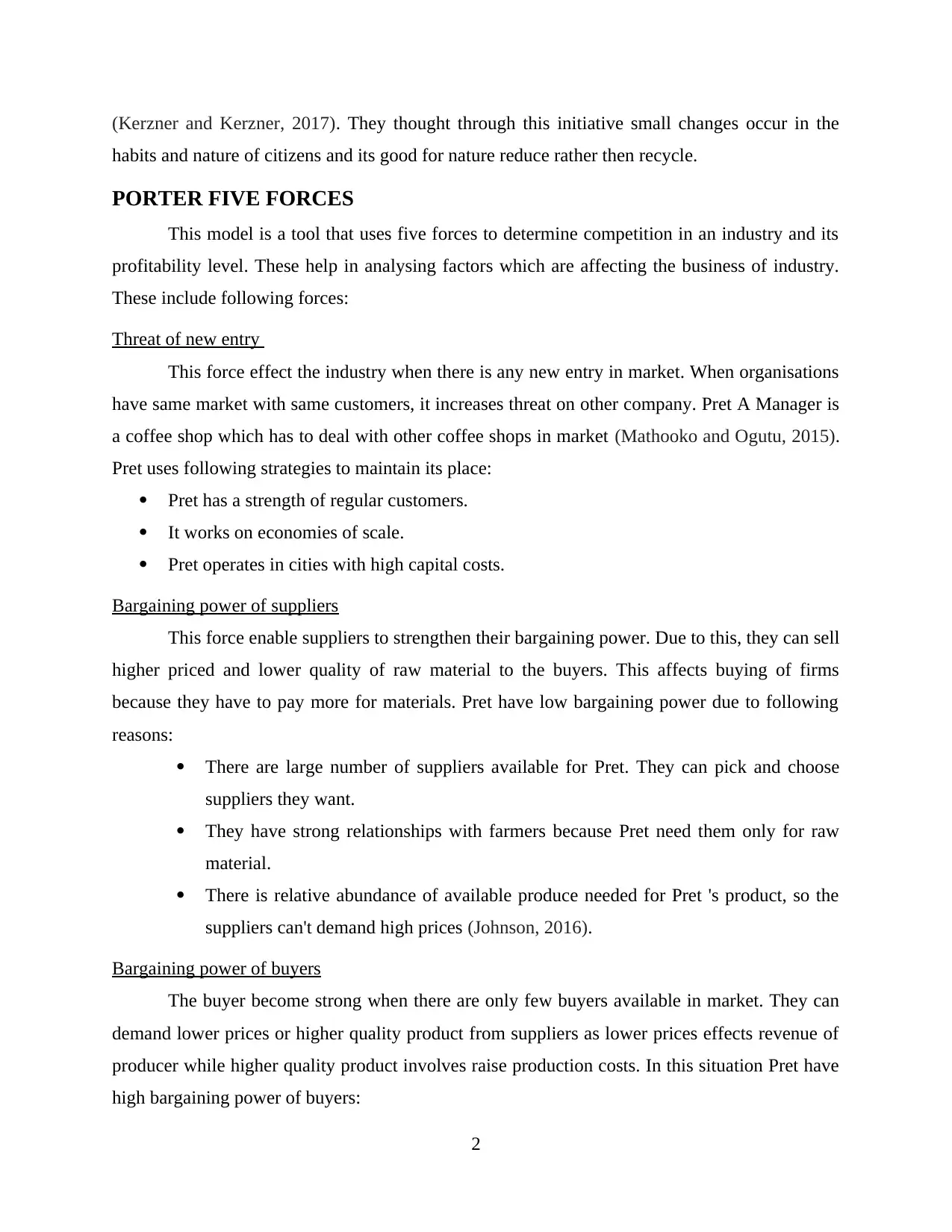
(Kerzner and Kerzner, 2017). They thought through this initiative small changes occur in the
habits and nature of citizens and its good for nature reduce rather then recycle.
PORTER FIVE FORCES
This model is a tool that uses five forces to determine competition in an industry and its
profitability level. These help in analysing factors which are affecting the business of industry.
These include following forces:
Threat of new entry
This force effect the industry when there is any new entry in market. When organisations
have same market with same customers, it increases threat on other company. Pret A Manager is
a coffee shop which has to deal with other coffee shops in market (Mathooko and Ogutu, 2015).
Pret uses following strategies to maintain its place:
Pret has a strength of regular customers.
It works on economies of scale.
Pret operates in cities with high capital costs.
Bargaining power of suppliers
This force enable suppliers to strengthen their bargaining power. Due to this, they can sell
higher priced and lower quality of raw material to the buyers. This affects buying of firms
because they have to pay more for materials. Pret have low bargaining power due to following
reasons:
There are large number of suppliers available for Pret. They can pick and choose
suppliers they want.
They have strong relationships with farmers because Pret need them only for raw
material.
There is relative abundance of available produce needed for Pret 's product, so the
suppliers can't demand high prices (Johnson, 2016).
Bargaining power of buyers
The buyer become strong when there are only few buyers available in market. They can
demand lower prices or higher quality product from suppliers as lower prices effects revenue of
producer while higher quality product involves raise production costs. In this situation Pret have
high bargaining power of buyers:
2
habits and nature of citizens and its good for nature reduce rather then recycle.
PORTER FIVE FORCES
This model is a tool that uses five forces to determine competition in an industry and its
profitability level. These help in analysing factors which are affecting the business of industry.
These include following forces:
Threat of new entry
This force effect the industry when there is any new entry in market. When organisations
have same market with same customers, it increases threat on other company. Pret A Manager is
a coffee shop which has to deal with other coffee shops in market (Mathooko and Ogutu, 2015).
Pret uses following strategies to maintain its place:
Pret has a strength of regular customers.
It works on economies of scale.
Pret operates in cities with high capital costs.
Bargaining power of suppliers
This force enable suppliers to strengthen their bargaining power. Due to this, they can sell
higher priced and lower quality of raw material to the buyers. This affects buying of firms
because they have to pay more for materials. Pret have low bargaining power due to following
reasons:
There are large number of suppliers available for Pret. They can pick and choose
suppliers they want.
They have strong relationships with farmers because Pret need them only for raw
material.
There is relative abundance of available produce needed for Pret 's product, so the
suppliers can't demand high prices (Johnson, 2016).
Bargaining power of buyers
The buyer become strong when there are only few buyers available in market. They can
demand lower prices or higher quality product from suppliers as lower prices effects revenue of
producer while higher quality product involves raise production costs. In this situation Pret have
high bargaining power of buyers:
2
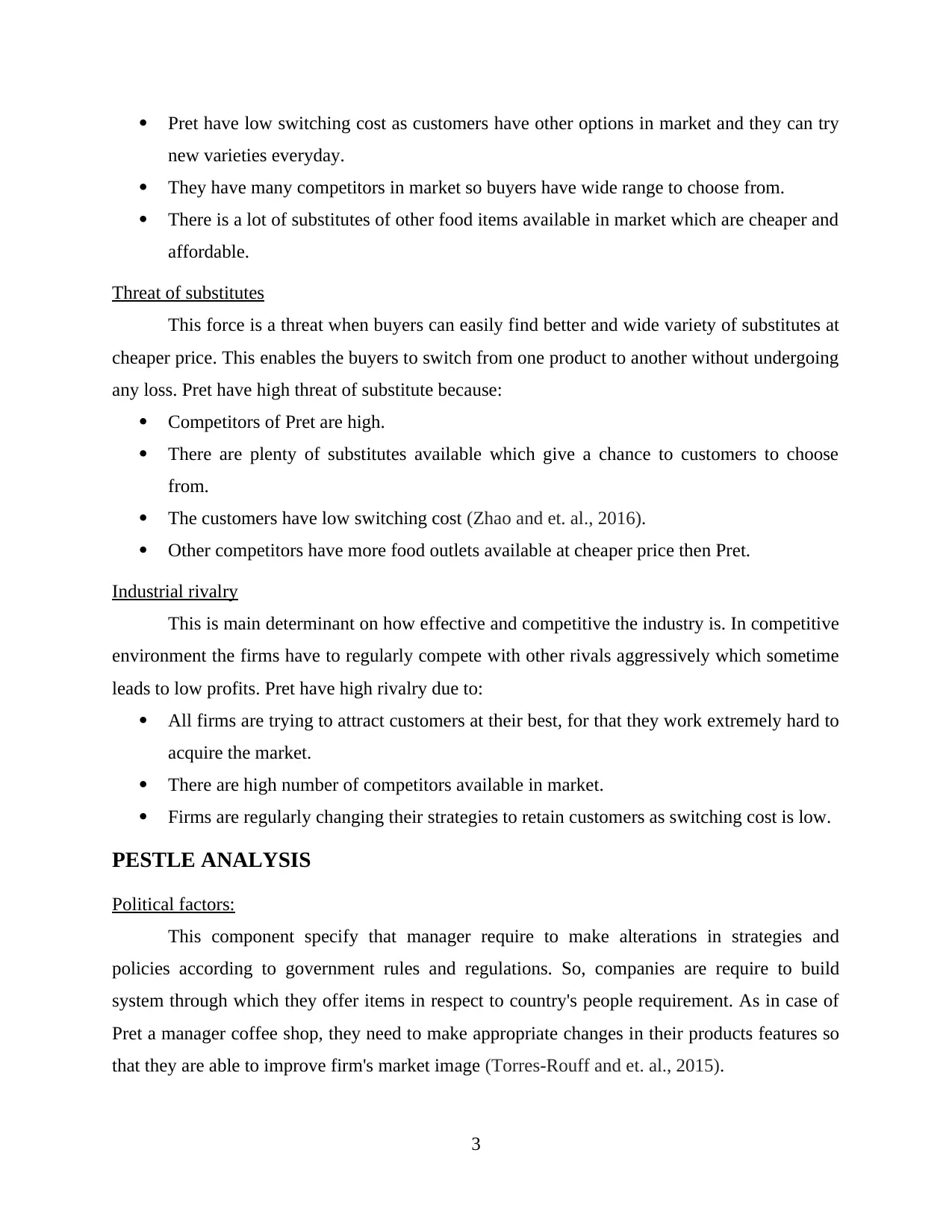
Pret have low switching cost as customers have other options in market and they can try
new varieties everyday.
They have many competitors in market so buyers have wide range to choose from.
There is a lot of substitutes of other food items available in market which are cheaper and
affordable.
Threat of substitutes
This force is a threat when buyers can easily find better and wide variety of substitutes at
cheaper price. This enables the buyers to switch from one product to another without undergoing
any loss. Pret have high threat of substitute because:
Competitors of Pret are high.
There are plenty of substitutes available which give a chance to customers to choose
from.
The customers have low switching cost (Zhao and et. al., 2016).
Other competitors have more food outlets available at cheaper price then Pret.
Industrial rivalry
This is main determinant on how effective and competitive the industry is. In competitive
environment the firms have to regularly compete with other rivals aggressively which sometime
leads to low profits. Pret have high rivalry due to:
All firms are trying to attract customers at their best, for that they work extremely hard to
acquire the market.
There are high number of competitors available in market.
Firms are regularly changing their strategies to retain customers as switching cost is low.
PESTLE ANALYSIS
Political factors:
This component specify that manager require to make alterations in strategies and
policies according to government rules and regulations. So, companies are require to build
system through which they offer items in respect to country's people requirement. As in case of
Pret a manager coffee shop, they need to make appropriate changes in their products features so
that they are able to improve firm's market image (Torres‐Rouff and et. al., 2015).
3
new varieties everyday.
They have many competitors in market so buyers have wide range to choose from.
There is a lot of substitutes of other food items available in market which are cheaper and
affordable.
Threat of substitutes
This force is a threat when buyers can easily find better and wide variety of substitutes at
cheaper price. This enables the buyers to switch from one product to another without undergoing
any loss. Pret have high threat of substitute because:
Competitors of Pret are high.
There are plenty of substitutes available which give a chance to customers to choose
from.
The customers have low switching cost (Zhao and et. al., 2016).
Other competitors have more food outlets available at cheaper price then Pret.
Industrial rivalry
This is main determinant on how effective and competitive the industry is. In competitive
environment the firms have to regularly compete with other rivals aggressively which sometime
leads to low profits. Pret have high rivalry due to:
All firms are trying to attract customers at their best, for that they work extremely hard to
acquire the market.
There are high number of competitors available in market.
Firms are regularly changing their strategies to retain customers as switching cost is low.
PESTLE ANALYSIS
Political factors:
This component specify that manager require to make alterations in strategies and
policies according to government rules and regulations. So, companies are require to build
system through which they offer items in respect to country's people requirement. As in case of
Pret a manager coffee shop, they need to make appropriate changes in their products features so
that they are able to improve firm's market image (Torres‐Rouff and et. al., 2015).
3
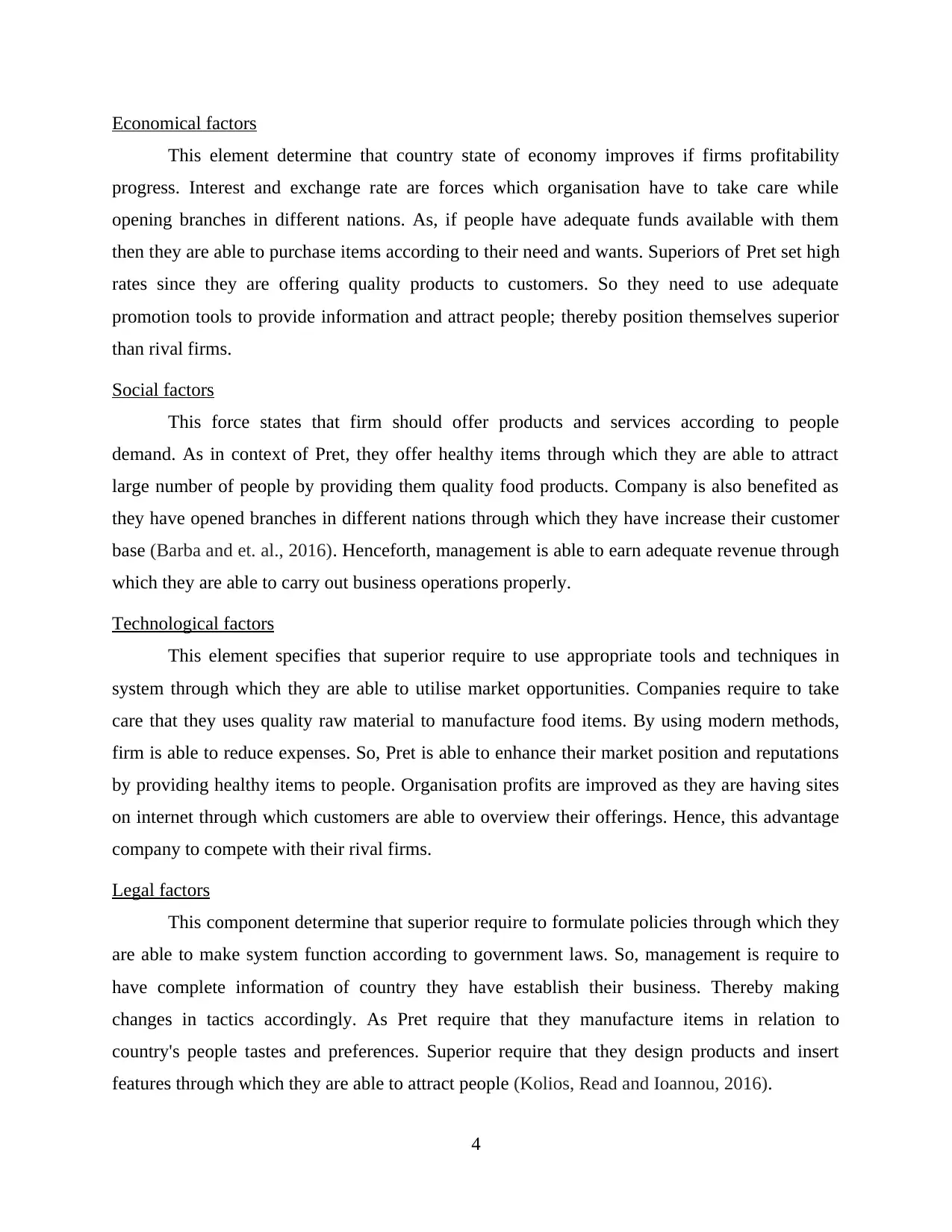
Economical factors
This element determine that country state of economy improves if firms profitability
progress. Interest and exchange rate are forces which organisation have to take care while
opening branches in different nations. As, if people have adequate funds available with them
then they are able to purchase items according to their need and wants. Superiors of Pret set high
rates since they are offering quality products to customers. So they need to use adequate
promotion tools to provide information and attract people; thereby position themselves superior
than rival firms.
Social factors
This force states that firm should offer products and services according to people
demand. As in context of Pret, they offer healthy items through which they are able to attract
large number of people by providing them quality food products. Company is also benefited as
they have opened branches in different nations through which they have increase their customer
base (Barba and et. al., 2016). Henceforth, management is able to earn adequate revenue through
which they are able to carry out business operations properly.
Technological factors
This element specifies that superior require to use appropriate tools and techniques in
system through which they are able to utilise market opportunities. Companies require to take
care that they uses quality raw material to manufacture food items. By using modern methods,
firm is able to reduce expenses. So, Pret is able to enhance their market position and reputations
by providing healthy items to people. Organisation profits are improved as they are having sites
on internet through which customers are able to overview their offerings. Hence, this advantage
company to compete with their rival firms.
Legal factors
This component determine that superior require to formulate policies through which they
are able to make system function according to government laws. So, management is require to
have complete information of country they have establish their business. Thereby making
changes in tactics accordingly. As Pret require that they manufacture items in relation to
country's people tastes and preferences. Superior require that they design products and insert
features through which they are able to attract people (Kolios, Read and Ioannou, 2016).
4
This element determine that country state of economy improves if firms profitability
progress. Interest and exchange rate are forces which organisation have to take care while
opening branches in different nations. As, if people have adequate funds available with them
then they are able to purchase items according to their need and wants. Superiors of Pret set high
rates since they are offering quality products to customers. So they need to use adequate
promotion tools to provide information and attract people; thereby position themselves superior
than rival firms.
Social factors
This force states that firm should offer products and services according to people
demand. As in context of Pret, they offer healthy items through which they are able to attract
large number of people by providing them quality food products. Company is also benefited as
they have opened branches in different nations through which they have increase their customer
base (Barba and et. al., 2016). Henceforth, management is able to earn adequate revenue through
which they are able to carry out business operations properly.
Technological factors
This element specifies that superior require to use appropriate tools and techniques in
system through which they are able to utilise market opportunities. Companies require to take
care that they uses quality raw material to manufacture food items. By using modern methods,
firm is able to reduce expenses. So, Pret is able to enhance their market position and reputations
by providing healthy items to people. Organisation profits are improved as they are having sites
on internet through which customers are able to overview their offerings. Hence, this advantage
company to compete with their rival firms.
Legal factors
This component determine that superior require to formulate policies through which they
are able to make system function according to government laws. So, management is require to
have complete information of country they have establish their business. Thereby making
changes in tactics accordingly. As Pret require that they manufacture items in relation to
country's people tastes and preferences. Superior require that they design products and insert
features through which they are able to attract people (Kolios, Read and Ioannou, 2016).
4
Paraphrase This Document
Need a fresh take? Get an instant paraphrase of this document with our AI Paraphraser
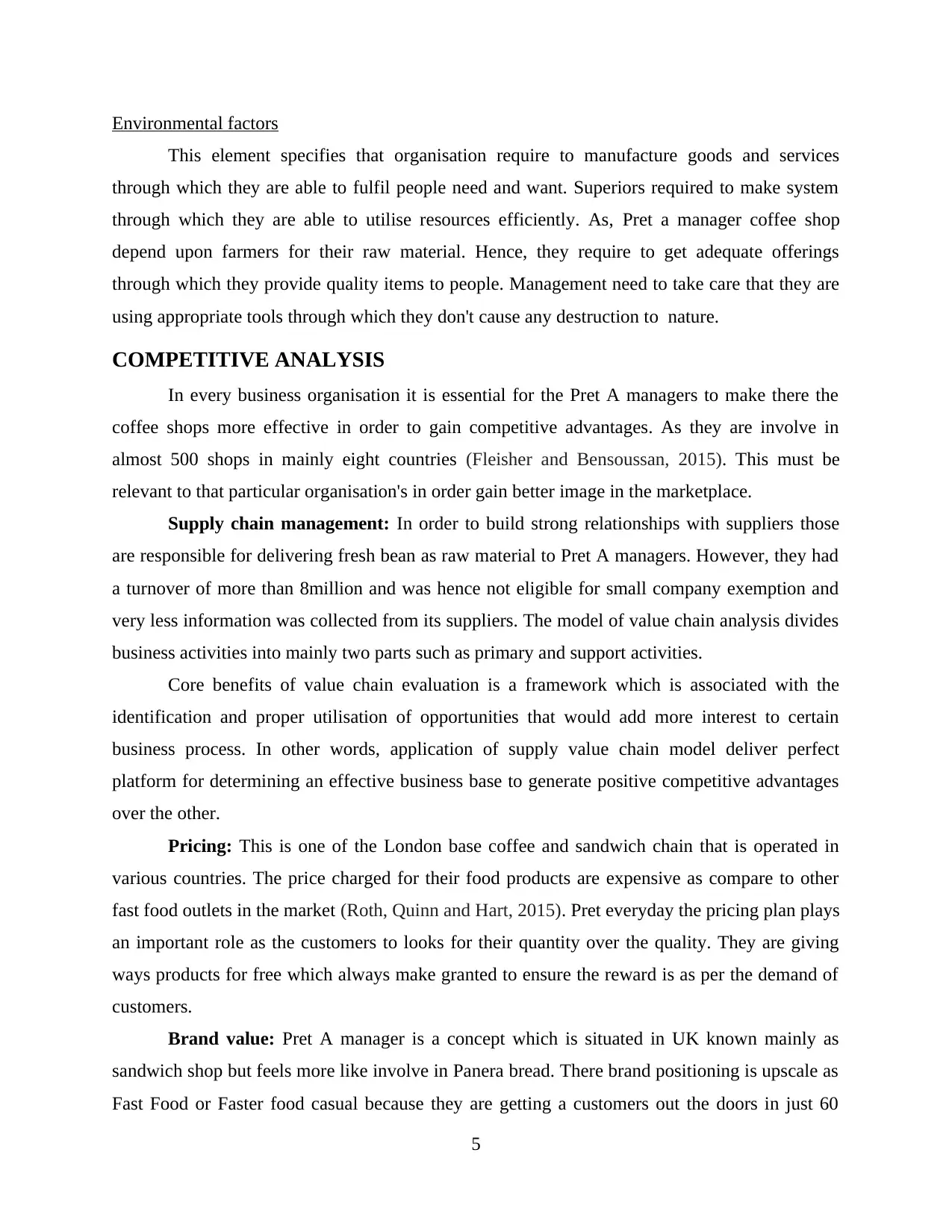
Environmental factors
This element specifies that organisation require to manufacture goods and services
through which they are able to fulfil people need and want. Superiors required to make system
through which they are able to utilise resources efficiently. As, Pret a manager coffee shop
depend upon farmers for their raw material. Hence, they require to get adequate offerings
through which they provide quality items to people. Management need to take care that they are
using appropriate tools through which they don't cause any destruction to nature.
COMPETITIVE ANALYSIS
In every business organisation it is essential for the Pret A managers to make there the
coffee shops more effective in order to gain competitive advantages. As they are involve in
almost 500 shops in mainly eight countries (Fleisher and Bensoussan, 2015). This must be
relevant to that particular organisation's in order gain better image in the marketplace.
Supply chain management: In order to build strong relationships with suppliers those
are responsible for delivering fresh bean as raw material to Pret A managers. However, they had
a turnover of more than 8million and was hence not eligible for small company exemption and
very less information was collected from its suppliers. The model of value chain analysis divides
business activities into mainly two parts such as primary and support activities.
Core benefits of value chain evaluation is a framework which is associated with the
identification and proper utilisation of opportunities that would add more interest to certain
business process. In other words, application of supply value chain model deliver perfect
platform for determining an effective business base to generate positive competitive advantages
over the other.
Pricing: This is one of the London base coffee and sandwich chain that is operated in
various countries. The price charged for their food products are expensive as compare to other
fast food outlets in the market (Roth, Quinn and Hart, 2015). Pret everyday the pricing plan plays
an important role as the customers to looks for their quantity over the quality. They are giving
ways products for free which always make granted to ensure the reward is as per the demand of
customers.
Brand value: Pret A manager is a concept which is situated in UK known mainly as
sandwich shop but feels more like involve in Panera bread. There brand positioning is upscale as
Fast Food or Faster food casual because they are getting a customers out the doors in just 60
5
This element specifies that organisation require to manufacture goods and services
through which they are able to fulfil people need and want. Superiors required to make system
through which they are able to utilise resources efficiently. As, Pret a manager coffee shop
depend upon farmers for their raw material. Hence, they require to get adequate offerings
through which they provide quality items to people. Management need to take care that they are
using appropriate tools through which they don't cause any destruction to nature.
COMPETITIVE ANALYSIS
In every business organisation it is essential for the Pret A managers to make there the
coffee shops more effective in order to gain competitive advantages. As they are involve in
almost 500 shops in mainly eight countries (Fleisher and Bensoussan, 2015). This must be
relevant to that particular organisation's in order gain better image in the marketplace.
Supply chain management: In order to build strong relationships with suppliers those
are responsible for delivering fresh bean as raw material to Pret A managers. However, they had
a turnover of more than 8million and was hence not eligible for small company exemption and
very less information was collected from its suppliers. The model of value chain analysis divides
business activities into mainly two parts such as primary and support activities.
Core benefits of value chain evaluation is a framework which is associated with the
identification and proper utilisation of opportunities that would add more interest to certain
business process. In other words, application of supply value chain model deliver perfect
platform for determining an effective business base to generate positive competitive advantages
over the other.
Pricing: This is one of the London base coffee and sandwich chain that is operated in
various countries. The price charged for their food products are expensive as compare to other
fast food outlets in the market (Roth, Quinn and Hart, 2015). Pret everyday the pricing plan plays
an important role as the customers to looks for their quantity over the quality. They are giving
ways products for free which always make granted to ensure the reward is as per the demand of
customers.
Brand value: Pret A manager is a concept which is situated in UK known mainly as
sandwich shop but feels more like involve in Panera bread. There brand positioning is upscale as
Fast Food or Faster food casual because they are getting a customers out the doors in just 60
5
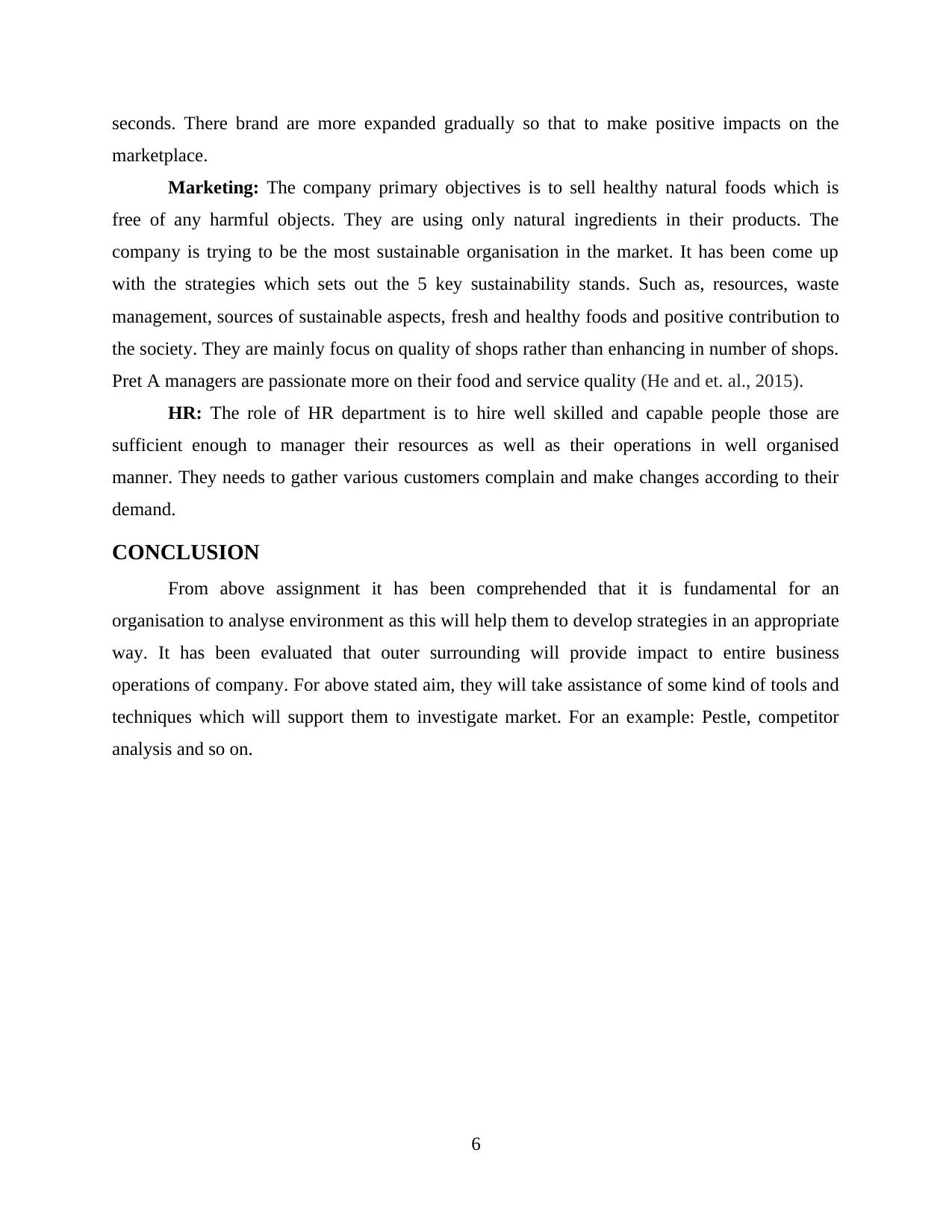
seconds. There brand are more expanded gradually so that to make positive impacts on the
marketplace.
Marketing: The company primary objectives is to sell healthy natural foods which is
free of any harmful objects. They are using only natural ingredients in their products. The
company is trying to be the most sustainable organisation in the market. It has been come up
with the strategies which sets out the 5 key sustainability stands. Such as, resources, waste
management, sources of sustainable aspects, fresh and healthy foods and positive contribution to
the society. They are mainly focus on quality of shops rather than enhancing in number of shops.
Pret A managers are passionate more on their food and service quality (He and et. al., 2015).
HR: The role of HR department is to hire well skilled and capable people those are
sufficient enough to manager their resources as well as their operations in well organised
manner. They needs to gather various customers complain and make changes according to their
demand.
CONCLUSION
From above assignment it has been comprehended that it is fundamental for an
organisation to analyse environment as this will help them to develop strategies in an appropriate
way. It has been evaluated that outer surrounding will provide impact to entire business
operations of company. For above stated aim, they will take assistance of some kind of tools and
techniques which will support them to investigate market. For an example: Pestle, competitor
analysis and so on.
6
marketplace.
Marketing: The company primary objectives is to sell healthy natural foods which is
free of any harmful objects. They are using only natural ingredients in their products. The
company is trying to be the most sustainable organisation in the market. It has been come up
with the strategies which sets out the 5 key sustainability stands. Such as, resources, waste
management, sources of sustainable aspects, fresh and healthy foods and positive contribution to
the society. They are mainly focus on quality of shops rather than enhancing in number of shops.
Pret A managers are passionate more on their food and service quality (He and et. al., 2015).
HR: The role of HR department is to hire well skilled and capable people those are
sufficient enough to manager their resources as well as their operations in well organised
manner. They needs to gather various customers complain and make changes according to their
demand.
CONCLUSION
From above assignment it has been comprehended that it is fundamental for an
organisation to analyse environment as this will help them to develop strategies in an appropriate
way. It has been evaluated that outer surrounding will provide impact to entire business
operations of company. For above stated aim, they will take assistance of some kind of tools and
techniques which will support them to investigate market. For an example: Pestle, competitor
analysis and so on.
6
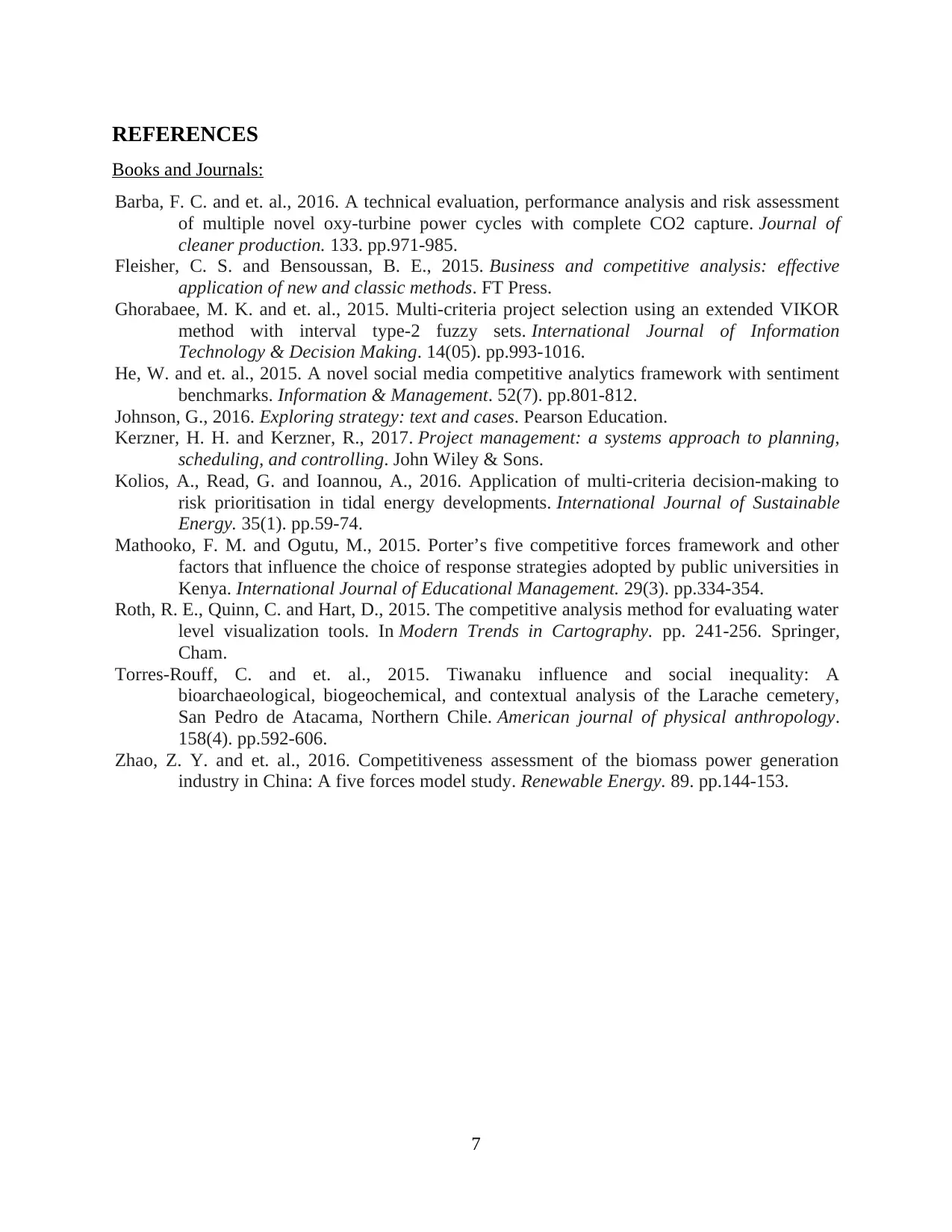
REFERENCES
Books and Journals:
Barba, F. C. and et. al., 2016. A technical evaluation, performance analysis and risk assessment
of multiple novel oxy-turbine power cycles with complete CO2 capture. Journal of
cleaner production. 133. pp.971-985.
Fleisher, C. S. and Bensoussan, B. E., 2015. Business and competitive analysis: effective
application of new and classic methods. FT Press.
Ghorabaee, M. K. and et. al., 2015. Multi-criteria project selection using an extended VIKOR
method with interval type-2 fuzzy sets. International Journal of Information
Technology & Decision Making. 14(05). pp.993-1016.
He, W. and et. al., 2015. A novel social media competitive analytics framework with sentiment
benchmarks. Information & Management. 52(7). pp.801-812.
Johnson, G., 2016. Exploring strategy: text and cases. Pearson Education.
Kerzner, H. H. and Kerzner, R., 2017. Project management: a systems approach to planning,
scheduling, and controlling. John Wiley & Sons.
Kolios, A., Read, G. and Ioannou, A., 2016. Application of multi-criteria decision-making to
risk prioritisation in tidal energy developments. International Journal of Sustainable
Energy. 35(1). pp.59-74.
Mathooko, F. M. and Ogutu, M., 2015. Porter’s five competitive forces framework and other
factors that influence the choice of response strategies adopted by public universities in
Kenya. International Journal of Educational Management. 29(3). pp.334-354.
Roth, R. E., Quinn, C. and Hart, D., 2015. The competitive analysis method for evaluating water
level visualization tools. In Modern Trends in Cartography. pp. 241-256. Springer,
Cham.
Torres‐Rouff, C. and et. al., 2015. Tiwanaku influence and social inequality: A
bioarchaeological, biogeochemical, and contextual analysis of the Larache cemetery,
San Pedro de Atacama, Northern Chile. American journal of physical anthropology.
158(4). pp.592-606.
Zhao, Z. Y. and et. al., 2016. Competitiveness assessment of the biomass power generation
industry in China: A five forces model study. Renewable Energy. 89. pp.144-153.
7
Books and Journals:
Barba, F. C. and et. al., 2016. A technical evaluation, performance analysis and risk assessment
of multiple novel oxy-turbine power cycles with complete CO2 capture. Journal of
cleaner production. 133. pp.971-985.
Fleisher, C. S. and Bensoussan, B. E., 2015. Business and competitive analysis: effective
application of new and classic methods. FT Press.
Ghorabaee, M. K. and et. al., 2015. Multi-criteria project selection using an extended VIKOR
method with interval type-2 fuzzy sets. International Journal of Information
Technology & Decision Making. 14(05). pp.993-1016.
He, W. and et. al., 2015. A novel social media competitive analytics framework with sentiment
benchmarks. Information & Management. 52(7). pp.801-812.
Johnson, G., 2016. Exploring strategy: text and cases. Pearson Education.
Kerzner, H. H. and Kerzner, R., 2017. Project management: a systems approach to planning,
scheduling, and controlling. John Wiley & Sons.
Kolios, A., Read, G. and Ioannou, A., 2016. Application of multi-criteria decision-making to
risk prioritisation in tidal energy developments. International Journal of Sustainable
Energy. 35(1). pp.59-74.
Mathooko, F. M. and Ogutu, M., 2015. Porter’s five competitive forces framework and other
factors that influence the choice of response strategies adopted by public universities in
Kenya. International Journal of Educational Management. 29(3). pp.334-354.
Roth, R. E., Quinn, C. and Hart, D., 2015. The competitive analysis method for evaluating water
level visualization tools. In Modern Trends in Cartography. pp. 241-256. Springer,
Cham.
Torres‐Rouff, C. and et. al., 2015. Tiwanaku influence and social inequality: A
bioarchaeological, biogeochemical, and contextual analysis of the Larache cemetery,
San Pedro de Atacama, Northern Chile. American journal of physical anthropology.
158(4). pp.592-606.
Zhao, Z. Y. and et. al., 2016. Competitiveness assessment of the biomass power generation
industry in China: A five forces model study. Renewable Energy. 89. pp.144-153.
7
1 out of 10
Your All-in-One AI-Powered Toolkit for Academic Success.
+13062052269
info@desklib.com
Available 24*7 on WhatsApp / Email
![[object Object]](/_next/static/media/star-bottom.7253800d.svg)
Unlock your academic potential
© 2024 | Zucol Services PVT LTD | All rights reserved.


